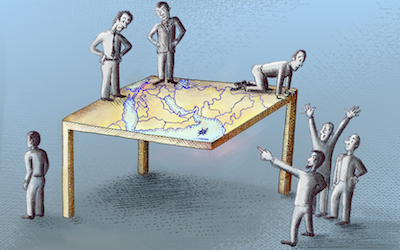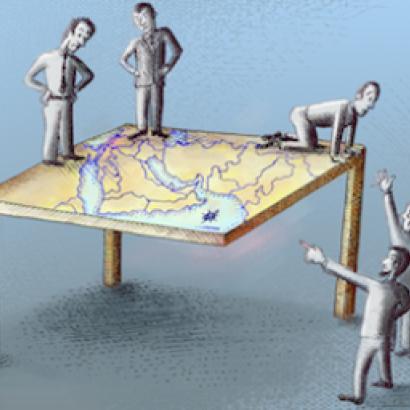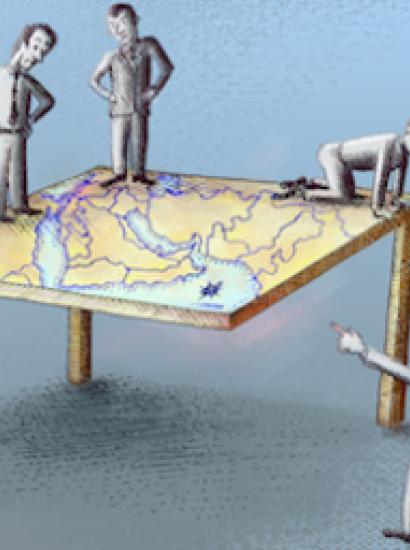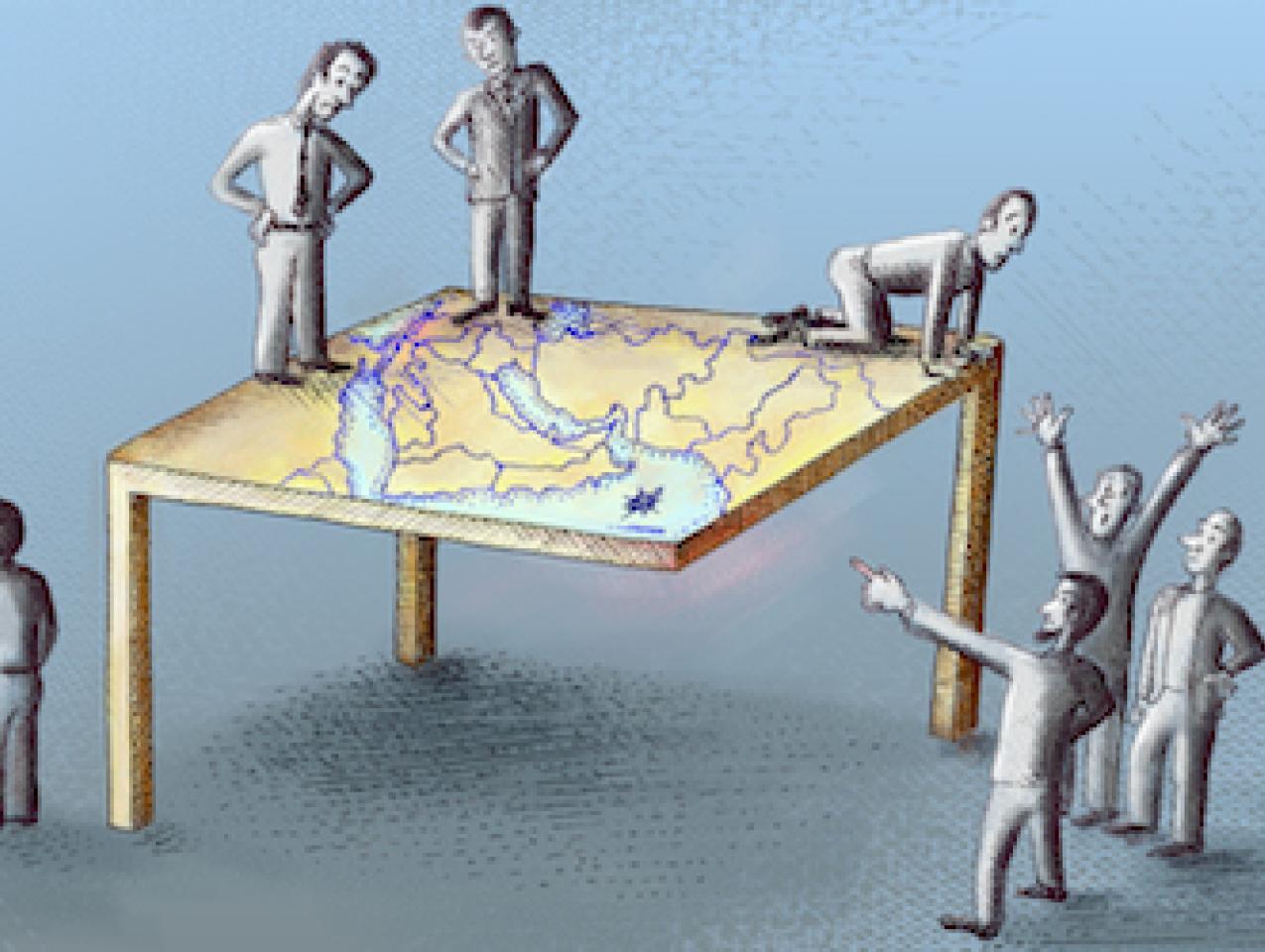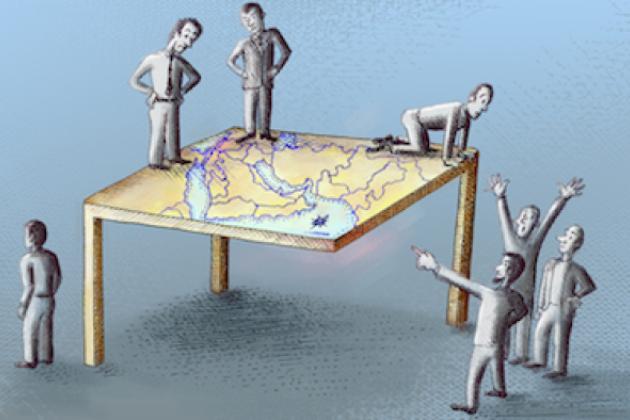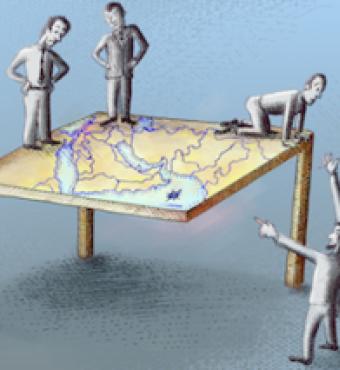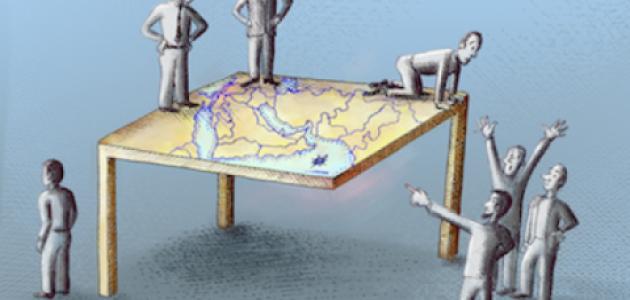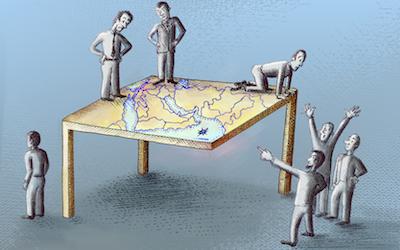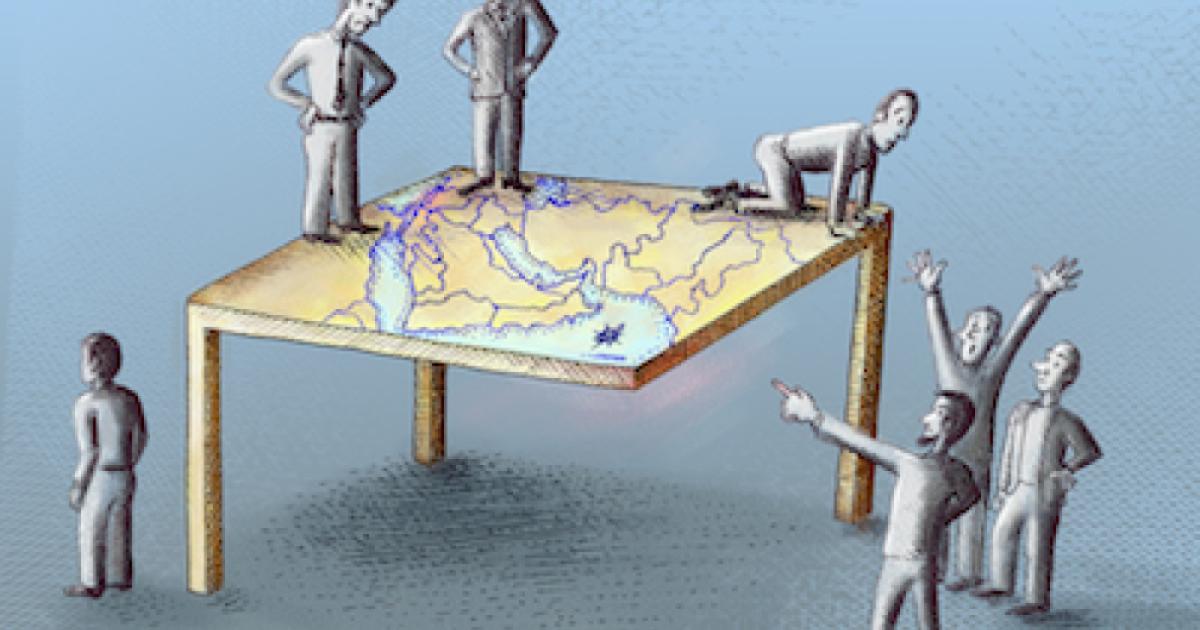Editor’s note: The following article is an excerpt from The Great Unraveling: The Remaking of the Middle East (Hoover), a series of essays by several distinguished Middle Eastern experts.
Israel looks at the Arab turmoil through a fractured lens: that of a powerful but anxious state, an important actor in Middle Eastern politics not fully integrated in the region, at peace with some Arab states and in conflict with other parts of the Arab and Muslim world.
During several decades, Israel’s leadership, like its predecessors in prestate Israel, saw the Arab world in terms of a “zero-sum game.” By the late 1930s, it transpired that a military conflict with the Palestinian Arabs was inevitable if a Jewish state was to be established and the Arab states adopted the Palestinian cause as their own and took charge of it. Within a few years, the Arab-Jewish conflict in and over Palestine was transformed by the 1948 war into the Arab-Israel conflict. The failure to end that war with a peace settlement led to the festering of the conflict and to three additional major wars—1956, 1967, and 1973.
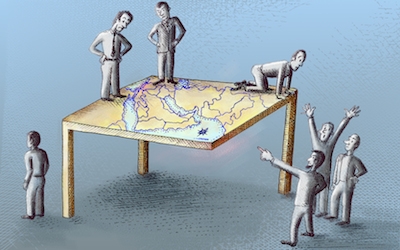
Illustration by Barbara Kelley
From this perspective, success and empowerment of the Arab collective was seen as detrimental to Israel. Israel despaired of breaking Arab hostility and therefore focused on seeking the cracks in that wall—minorities, rivalries—or on circumventing it by building bridges to the region’s “periphery”—Turkey, Iran, and Ethiopia—non-Arab states equally concerned with the power of pan-Arab nationalism in its heyday in the 1950s and 1960s.
This perspective began to change in 1979 with the signing of the Egyptian-Israeli peace treaty. Having made peace with the most important Arab state, did it make sense for Israel to continue to look for cracks in the wall of hostility or circumvent it, or did it make more sense to expand the opening and seek a comprehensive change in, if not a full transformation of, its relationship with the Arab world?
In the event, progress along such lines was slow and problematic. The peace process was suspended in practice for more than a decade. The Egyptian-Israeli peace treaty survived adversity, but its scope was limited to a bare minimum. First Anwar Sadat and then Hosni Mubarak followed a policy of a “cold peace” with Israel, keeping the essentials of the agreement but restricting the development of normal relations. This reality did not in fact bother the Israeli leadership that had its own ambivalent view of full peace and integration in the region. In any event, failure to move forward in resolving the Israeli-Palestinian conflict, the ongoing conflict with Syria, Iraq’s emergence as a major Arab power, and the regional ramifications of the Iranian revolution perpetuated the state of conflict and blunted the impact of Israeli-Egyptian peace.
The renewal of the peace process under the auspices of the Bush administration in Madrid in 1991 exposed the complexity of the effort to normalize Israeli’s relationship with its Arab environment. In 1993, Israel signed the Oslo Accord with the PLO, and Israel and the Palestinian national movement went through the act of mutual recognition and charted a road map for a resolution of their conflict. In theory, this should have paved the way for accelerated normalization with Egypt and other Arab states. In practice, Israel’s effort to use the agreement with the Palestinians in order to integrate itself into the region, most notably through Middle East economic conferences, provoked a negative Egyptian reaction. The Egyptian leadership (and in a different fashion, the Syrian one) was horrified by the vision Israel’s foreign minister, Shimon Peres, put forth in his book The New Middle East and in his concept of peace with Syria in late 1995 and early 1996. Peres was the first Israeli leader to formulate a view of Israel’s relationship with the Arab world departing from the “zero-sum” concept of earlier decades.
But while Peres genuinely saw economic cooperation as a key to a stable peace in a more prosperous region, Egyptians, Syrians, and other Arabs saw it as neocolonialism, a sophisticated and cunning Israeli strategy to control the region. In the Syrian case, this remained a hypothetical issue, but the Egyptian political establishment, represented most notably by Foreign Minister Amr Moussa, while maintaining the peace treaty with Israel and offering some help in advancing the peace process, in fact saw Israel mostly as a competitor, threatening Egyptian primacy or hegemony. Egypt used the nuclear issue in order to undermine the multilateral track of the peace process. At home, Mubarak’s regime allowed virulent criticism of Israel by Islamists and neo-Nasserite opposition groups as a way of building a common platform with the opposition on at least one issue.
The vision and threat of Israel at the end of a successful quest for a comprehensive peace settlement with its Arab neighbors becoming integrated into its environment evaporated in the late 1990s, when the momentum of the Madrid and Oslo processes was checked and the peace process came to a halt. Two major efforts were endorsed to renew a peace process and to complete Israel’s negotiations with Syria and the Palestinians during the terms of Ehud Barak and Ehud Olmert, but both failed and the reality of Israel’s relationship with its environment remained checkered: cold peace with Egypt and Jordan, partial normalization with several Arab states in North Africa and the Gulf, a continuation of Israel’s conflict with a fragmented Palestinian counterpart, and continued conflict with Syria conducted mostly through Lebanon.
During the first decade of the current century, the Middle Eastern arena was transformed by the new roles played by Turkey and Iran. The twentieth century was exceptional in the region’s history due to the absence of successor states of the Ottoman and Persian empires that had dominated the region for centuries. The Turkish state, shaped and inspired by Mustafa Kemal Ataturk, saw itself mostly as a European state with limited interest in the Middle East. Iran under the shah was preoccupied with the Soviet threat and domestic issues. It did play a role in the Middle East but not one commensurate with its potential. 1979 was to prove a year of great upheaval. The Islamic Revolution brought to power a regime seeking to export its design first and foremost to the Arab world, but the success of that policy was limited and its main achievements were the construction of a power base in the Shiite community in Lebanon and an alliance with Syria. For both Turkey and Iran, 2003 was in that regard a turning point.
In Turkey, Recep Tayyip Erdogan came to power and began to pursue a new foreign policy. Rebuffed by Europe, Turkey under an Islamist government was now seeking a hegemonic role in the Middle East. The American invasion of Iraq and the destruction of Saddam Hussein’s regime removed a significant barrier for Iran’s ayatollahs. Iran could now look for paramount influence in a Shiite-dominated Iraq and accelerate its drive for influence in other parts of the Middle East. The regional politics of the Middle East were not governed by a single issue, but the conflict between Iran and its rivals was the single most important variable in that system. This rivalry served, among other things, to expose Israel’s problematic position in the region. It shared the animosity toward the Iranian regime and the opposition to its nuclear program and regional ambitions with states like Egypt, Saudi Arabia, and Jordan. But given the ongoing conflict with the Palestinians, the limited scope of its peaceful relationship with Egypt and Jordan, and the absence of a relationship with Saudi Arabia, it could not in fact become part of an effective anti-Iranian bloc.
The Outbreak of the “Arab Spring”
Against this backdrop, Israel’s reaction to the outbreak of what was initially named “the Arab Spring” and its early development in 2010 and 2011 was ambivalent. Israel’s prime minister at the time, Benjamin Netanyahu, argued in a book he wrote in 1993 that the main obstacle to peace in the Middle East was the fact that all states in the region other than Israel were governed by non-democratic regimes. For real peace between Israel and its neighbors to be achieved, its neighbors had first to undergo a transition to democracy. In later years, the chief advocate of the need for democratic transformation in the Arab world in the ranks of the Israeli right wing was Natan Sharansky. But while Sharansky was un-equivocal in his positive response to the events in Tunisia and Egypt, Netanyahu’s response was ambivalent at best.
Most of Netanyahu’s statements and responses in Israel were negative or doubtful. In his first public reaction to the Tunisian revolution on January 16, 2011, Netanyahu failed to refer to the democratic dimension of the event and chose to describe it as reflecting the unstable character of the Middle East. “The region we live in,” Netanyahu said, “is unstable. We see that in several occasions in the geographic space within which we live.” His initial response to the outburst of protest in Egypt on January 31, 2011, was similar—failure to mention the quest for democracy and stating his concern that events in Egypt could lead to the establishment of “a repressive regime of radical Islam.” “In such a regime,” said Netanyahu, “human rights are trampled and they constitute danger for peace.” Nearly a year later, speaking at the opening of the Knesset session on October 31, 2011, Netanyahu spoke in some detail on developments in the Arab world and pinpointed his message: “If I had to summarize what we can expect in the region I would use two terms: instability and uncertainty. [. . .] To confront the uncertainty and instability facing us, we need two things: power and responsibility.” He further stated that “if religious extremism does not moderate its outlook, it is doubtful whether the great expectations that flowered with the flourishing of the Arab spring will materialize; it is possible that the implementation of these hopes will be postponed for the next generation.”
A month later, Netanyahu offered a still darker perspective and added a note of criticism directed at those who saw the events in the Arab world in a positive optimistic light. “The Middle East is no place for the innocent,” he said.
Last February I stood on this podium. Millions of Egyptian citizens filled the streets of Cairo. It was explained to me by commentators, and quite a few of my colleagues here at the opposition, that we are facing a new age of liberalism and progress that will wash away the old order. [. . .] I said that we are hoping that all of this will materialize but with all due respect for all hopes, it is most likely that an Islamist wave will wash the Arab states, an anti-Western, anti-liberal, anti-Israel and ultimately anti-democratic wave. I was told that I was trying to frighten the public but I do not see that we are on the wrong side of history, that I do not understand in what direction things are moving. They are moving but not forward towards progress. They are go-ing backward. I chose to adapt our policy to reality and not to the heart’s wishes. I am asking today who among us did not understand reality? Who among us misunderstood history?
Netanyahu and other Israeli politicians or analysts who emphasized the dark side of the Arab Spring from Israel’s perspective were challenged by other voices—some of them more moderate politicians like Dan Meridor and Tzipi Livni and most forcefully by Peres, the president of the state of Israel. In April 1, 2011, Peres penned an op-ed in the Guardian, “We in Israel welcome the Arab Spring.” Peres repeated his view on other occasions. In a speech in the Israeli parliament, the Knesset, on October 31, 2011, he stated that “undoubtedly, it is for the good of the whole region, including Israel, that a new order will arrive, that a Middle East will emerge with food to eat and freedom to breathe. The Struggle is unfolding and it cannot be judged by the first act or a single act.”
On several occasions, speaking abroad or to international audiences, Netanyahu adopted a more positive tone with regard to events in the Arab world, but clearly his domestic statements reflected his true outlook. By choosing the term “the right side of history,” Netanyahu was in fact taking issue with President Obama, who was initially supportive of what seemed to be an Arab Spring, seeking to place himself “on the right side of history.” The first year of the Arab Spring was a period of sharp differences between the US president and the Israeli prime minister. The main bone of contention was Obama’s quest for an Israeli-Palestinian settlement and his pressure on Netanyahu to go along with his policy.
We get a sense of the divergence between the Obama administration and the government of Netanyahu. In the memoirs of former Defense Secretary Robert Gates, Duty: Memoirs of a Secretary at War (2014), it’s March 2011, Gates is on a visit to Israel, and he calls on Minister of Defense Ehud Barak. Gates gives Barak his view of the events of the Arab Spring, reassures him that all is well with the Israel-Egypt treaty despite the turmoil in Egypt: “Speaking as a friend, I said now was the time for Israel not to hunker down but to act boldly in the region—to move on the peace process with the Palestinians, to reconcile with Turkey, and to help Jordan. I added that the good news about the turmoil in the region was that it was not about Israel or the United States—‘No one is burning U.S. or Israeli flags, yet’—but about internal problems in the Arab countries, and we needed to make sure that that remained the focus.” Gates was to have a rougher time the next day when he drove up to Caesarea for a meeting with Prime Minister Netanyahu. He urged Netanyahu not to go into a “defensive crouch but to seize the moment with bold moves in the peace process. Bibi wasn’t buying.”
Differences of opinion regarding Iran’s pursuit of a nuclear weapon were a second major bone of contention. These differences of opinion became related to the differing perspectives on the Arab Spring. Obama’s initial policy in the Middle East sought to promote democratic change, to bring about an American reconciliation with the Arab and Muslim worlds, to re-solve the Israeli-Palestinian conflict which he saw as a major reason for the tension between US and Arab and Muslim opinion, and to open a dialogue with Iran and Syria. This policy was reflected, among other things, in his 2009 Cairo speech, in the negative atmosphere that characterized Netanyahu’s first visit to Washington shortly after Obama’s inauguration and in the Obama administration’s refusal to offer public support to the demonstrators against the Ayatollah’s regime in 2009. In contrast, the Obama administration responded favorably to changes in Tunisia and Egypt, exerted pressure on Hosni Mubarak to leave office, and urged the Egyptian army to allow the free elections, which put Mohamed Morsi and the Muslim Brotherhood in power.
Netanyahu’s variant response was shared by the Israeli right wing and quite a few Israeli centrists who were dubious of the prospect for a real transition to democracy in Egypt and other Arab countries, and concerned about the effect on Israel of instability and the rise of Islamist forces in neighboring countries and in the region at large. This Israeli caution was to some extent shaped by the 2006 elections in the Palestinian Authority. Prime Minister Ariel Sharon yielded to the pressure of President George W. Bush and allowed the elections, which brought Hamas to power in Gaza. Bush’s outlook on democracy in the Arab world was different from that of Obama’s, but in the eyes of many Israeli policy-makers and observers, the outcome was the same. As they saw it, every free election in an Arab or Muslim country was bound to end in an Islamist victory with negative implications for Israel. For Netanyahu and other right-wing Israeli politicians, this was not the time for Israel to take risks and to make territorial concessions, first and foremost in the Palestinian context, and expose Israel to unnecessary risks in an unstable environment.
Israeli concerns about the ramifications of what began as the Arab Spring in Tunisia and Egypt were twofold: a fear that the whole Arab world might be swept by a radical, mostly Islamist wave, and a more immediate and focused concern that the peace treaties with Egypt and Jordan would be undermined by a radical takeover in both countries. In the event, King Abdullah and the Hashemite regime in Jordan were able to weather the storm and survived the wave of opposition inspired by events in Tunisia and Egypt. In Egypt, developments from Israel’s point of view were more complex, as described below.
There were two other elements in Israel’s response to the first month of the Arab Spring. Netanyahu and his government looked at these events as related to the issue that preoccupied Netanyahu the most: Iran’s quest for regional hegemony and a nuclear weapon. Mubarak’s fall, in particular, as well as the threat to the conservative and moderate regimes in the region, was seen as an Iranian gain. Iran’s opponents were weakened, and new opportunities became available to Tehran. And as can be seen in Netanyahu’s statements quoted above, a separate debate was taking place over the relationship between the Arab Spring and the Palestinian issue. For Barack Obama and the Israel left, progress in the Israeli-Palestinian negotiations was more urgent than ever. Being “on the right side of history” meant that by putting an end to the Israeli-Palestinian conflict, Israel would make its own contribution to progress in the region and benefit from the transition to democracy. For Netanyahu and other spokesmen of the Israeli right wing, the changes in Egypt
and elsewhere in the region meant that this was not the time to take risks or make territorial concessions.
Israel’s calculus changed over time as the initial hopes for a far-reaching positive transformation in the Arab world were replaced by a more complex, often darker, reality: the domestic developments in Egypt, the Saudi suppression of the revolt in neighboring Bahrain, the outbreak of the Syrian civil war, and the civil war and Western intervention in Libya. By 2012, it became clear that the political status quo in the Arab world was not going to be altered to a democratic landscape anytime soon, that the initial wave of the Arab Spring had changed Arab politics, but that a long, complex process was unfolding and the current policy by Israel and others had to be nuanced. Furthermore, the underlying questions changed. As the Syrian civil war festered and the prospect loomed of Syria being broken up with far-reaching ramifications for the neighboring states of Iraq and Lebanon, Israeli leaders had to formulate a policy addressing instability and the danger of jihadi terrorism rather than with the prospect for democratic change. We will now examine Israel’s thinking on these issues in several specific contexts… You may access the rest of the essay here.







